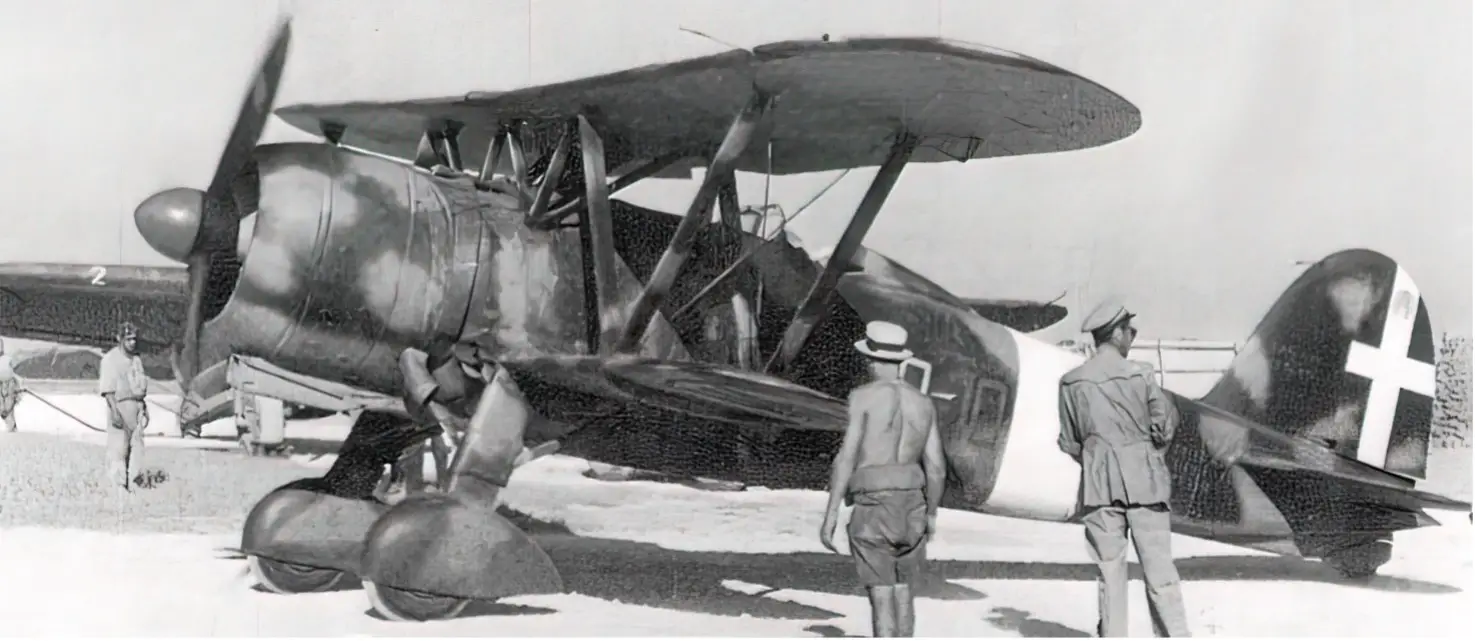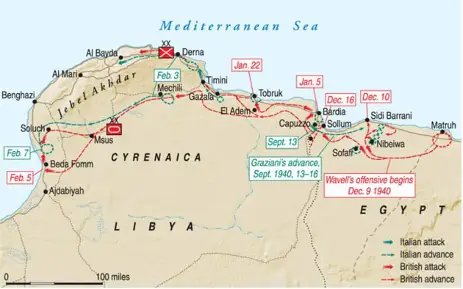Setting the stage
When Italy declared war on the Western allies, on June 10th, 1940, neither Benito Mussolini nor most of the military leadership thought North Africa would become the main theatre of operations. The eyes were pointed at the developments on the continent and the Italian expectations (and hopes) were that of a short war where Italy could have collected some valuable spoils.
In the Italian colony of Libya, the Regia Aeronautica (Italian Air Force) was ordered to maintain a defensive stance against allied forces in Tunisia and Egypt. At the time of the declaration of war, Libya’s air forces were composed of 134 bombers (107 S.M. 79 and 27 S.M.81) and 66 fighters (around 50 CR.32 and 11CR.42). In addition, there were some reconnaissance and transport aircraft and the 50° Stormo Assalto (Land attack wing), equipped with Breda BA 65 and CA310B (around 50 aircraft, but sources are a bit unclear).
The main opponent of the Regia Aeronautica in the theatre was the Western Desert Air Force deployed in Egypt, which at the time consisted of roughly 40 Gloster Gladiator fighters, 70 Blenheim bombers plus a few dozen more outdated aircraft. Both opponents would soon see more reinforcements coming in the theatre.
The air war begins
The beginning of hostilities saw immediately a series of incursions from British bombers, the first one launched on the 11th of June against the El Adem airfield (south-east of Tobruch) which managed to damage some Italian bombers on the ground. On this occasion, the CR.32 intercepted the attackers and managed to shoot down two bombers.
The day after, 27 CR.42 arrived in Libya from Italy to reinforce the ranks of the fighter force. On the 14th of June, Gloster Gladiators and CR.42 clashed for the first time over the Libyan desert while on the 19th the Italian fighters met for the first time in combat one Hawker Hurricane, one of the first machines of this type sent to the theatre.

Figure 1 A Breda BA 65 under maintenance
On the 28th of June, another bombing run was launched against the Tobruch airfields and at the end of the raid, amid smoke and confusion, the Italian AA land batteries mistakenly shot down the S.M. 79 carrying the Governor of Libya Marshal Italo Balbo, who was arriving in Tobruch.
With the capitulation of France, all the aircraft deployed in Western Libya (Triploitania) were progressively moved to the East (Cyrenaica). They were desperately needed because one relevant problem was becoming evident. The British land forces had begun to launch a series of incursions with small, motorized columns deep into Libyan territory. The Italian army was unable to counter these hit-and-run attacks because it lacked tanks, armored cars and sufficient motor transports. Thus, they continuously pressed the Air Force to intervene where needed.
This new task absorbed many resources and aircraft, augmenting the attrition level and not achieving that much, especially because purpose-built land attack aircraft were not available in large numbers. To this end, in July, 32 new Breda BA 88 land attack aircraft were sent to Libya but soon they proved to be useless, due to a series of design flaws and their insufficient engine power. After a brief operational activity, they were used as decoy targets around airfields.

Figure 2 A Breda BA 88 “Lince”
The months of July and August 1940 saw weekly air skirmishes between Italian and British fighters, usually in the context of respective escort/interception missions. The Regia Aeronautica, as mentioned before, was also absorbed by land surveillance and land attack duties.
In the meantime, the post held by Italo Balbo was assumed by Marshal Graziani who increasingly received pressures from Rome to launch an offensive towards Egypt, using the forces he had available. In Mussolini’s mind, this was to take place, at the latest, when German troops would have landed in Britain (as the Germans kept telling their allies that the invasion was imminent). Graziani, faced with the dire situation of his forces in Libya, managed to postpone the operation and receive some new reinforcements (like the 70 M11/39 tanks shipped in July).

Figure 3 a FIAT CR.42
The offensive was in the end launched in September, as he couldn’t fend off Rome’s pressuring requests and thus the Italian invasion of Egypt began. The Regia Aeronautica continued to carry out its tasks, with now additional missions over Egyptian territory. The offensive was short lived, as it stopped after a few days when the Italians reached Sidi El Barrani, at the extreme of the logistical capabilities of Graziani’s army. The months until December 1940, while relatively calm on the land front, saw the same level of air skirmishes as outlined before.
One big air clash took place on the 30th of October 1940 when 26 S.M. 79 escorted by 37 CR.42 flew to attack an airfield near Marsa Matruh. They were intercepted by a mixed formation of Hurricanes and Gladiators. The British shot down 1 fighter, 2 bombers and heavily damaged other two. The Italians shot down 2 Hurricanes and 5 Gladiators.
Operation Compass
On the night of the 9th of December, under the command of General Richard O’Connor, the Western Desert Force (WDF) attacked. The 7th armored and 4th Indian divisions passed through a gap between the camps of two Italian divisions and began ravaging the Italian front, held by non-mobile troops that could launch no or limited counterattacks. In the space of 5 days, the mobile British units had reached the border between Egypt and Libya and pushed through into the Italian colony.

Figure 4 Overview of the whole campaign December 1940-February 1941 (Source Military History Network)
At the beginning of the British offensive, the Italians in Libya could rely on a limited number of efficient aircraft, according to Marshal Graziani there were 45 bombers, 6 torpedo bombers, 12 land attack aircraft, 68 fighters and 4 transport aircraft. The units of the Regia Aeronautica relentlessly attacked when and where they could. The land attack aircraft like the Breda 65 or the CR.32 equipped with bombs flew numerous missions until exhaustion.
They did so facing increasing numbers of Hawker Hurricanes, against which only the CR.42 biplanes could be deployed. The British fighter was superior in all respects, the only chance for the Italian biplanes was to engage in a close and manoeuvred fight where they could leverage on their superior manoeuvrability. It was the case of an encounter on the 14th of December when 5 Hurricanes attacked 5 CR.42 in a very close fight and came out with their leader shot down and Italian fighters downed.
Epilogue, for now
The British offensive effectively expelled the Italians from Cyrenaica and the operations came to an end in early February, with the battle of Beda Fomm. Already on the 6th of January 1941, Graziani wrote to Mussolini that the Air Force in Libya was no more able to launch offensive operations due to the extreme exhaustion of its forces. It is estimated that during this time arc, the Italians had lost between 300 and 400 aircraft.
The Fight was over for now, but a new phase of the war in North Africa was about to begun. With the arrival of new Italian troops, the German Afrika Korps and the Luftwaffe (Fliegerführer Afrika), also new reinforcements for the Regia Aeronautica arrived, including new types of aircraft like the MC.200.
Sources
De Lorenzo, G., (1991), L’Aeronautica in guerra – 1° anno, pag. 85-132 in “L’Italia in Guerra” il primo anno -1940, Commissione Italiana di Storia Militare.
Galbiati, F. (2023). La caccia della Regia Aeronautica (1936-1943) Parte I, STORIA MILITARE
Sgarlato, N. (2000). La Regia Aeronautica nella II Guerra Mondiale. Delta Editrice.
Malizia, N. (2003). Il FIat C.R.42, l’ultimo biplano da caccia Italiano. Editrice Innocenti.